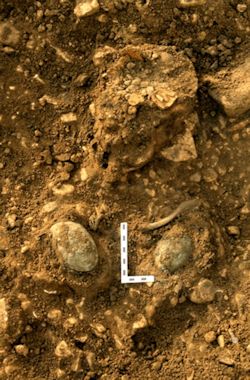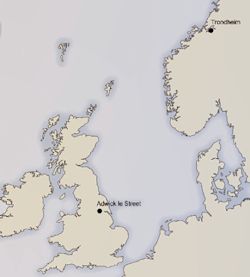
During the first half of the 9th century, the quantity of Insular finds from Trøndelag increases significantly, and the majority of the whole assemblage can be dated to this century. The imported goods were, in all probability, acquired through various processes and patterns of interaction, and it can be somewhat difficult to separate different forms of commodity exchange in the archaeological material. From written sources, we know that in many cases specific circumstances decided whether one chose to exchange gifts, conduct trading or plunder, and the different forms of exchange cannot always be viewed as strictly separate spheres (Skre 2007). Innovation in maritime technology is often highlighted as an important cause of the increased Norse interaction with the British Isles during this century (e.g. Sørheim 2011; Roesdahl 1994). After the development of more advanced sea-going sailing ships, the British Isles were considered as a fairly close destination, which in fine weather could be reached from western Norway in a couple of days (Wamers 1998, 52). It is likely therefore that the Insular world was well known to the people living in coastal Norway, and that there may have been regular crossings to and from Trøndelag.
Insular finds assemblages of various sizes are found at several central places spread around the Trondheimsfjord, with marked concentrations at the areas of Skaun, Stjørdal, Levanger and Steinkjer. These places are located at natural harbours with good farmland, but, more importantly, strategically placed to control shipping and trade with products from further inland. Such central places, strictly controlled by local leaders and chieftains, functioned as local centres for trade, exchange and craft production and also served as collection points for local products for export from neighbouring settlements (Christophersen 1989, 121; Sogness 1988). In Trøndelag, the location of numerous inland iron production sites, major trapping systems for larger animals and locations of soapstone quarries suggests that iron, hunting products and soapstone are likely to have been particularly important local products for trade and exchange. These items would have been brought from inland to local central places by the fjord, where many of the goods changed hands and were transferred to different vessels before being sent out of the region (Stenvik 1994; Herje 1989.). Income from such activities is likely to have been an important factor in obtaining and maintaining sufficient resources needed to equip and organise long-distance voyages during this century. The distribution of Insular and other imported objects is often used to identify central places, since such finds can be viewed as an indicator of the abilities certain areas and communities had to equip and organise overseas expeditions during the Viking Age (Sørheim 2010, 275).

The area of Stjørdal, 50km north of Trondheim, is notable for the highest concentration of 9th-century Insular finds from Trøndelag. Within a distance of approximately seven miles, some 12 burials containing such objects have been found. The western part of Stjørdal has large areas of excellent farmland, while the eastern part is dominated by the valley of the Stjørdal River and its estuary. In addition to the fluvial deposits providing rich agricultural land, the valley would also have been an important route eastwards towards Sweden, making Stjørdal strategically placed for trade and exchange during the Viking Age. Many of the Insular finds from this area are clustered on neighbouring farms, and this is especially noticeable around the mouth of the River Stjørdal. The dense concentration of Insular material is striking, indicating that this part of Stjørdal may have played an important role in equipping and organising overseas journeys within Uttrøndelag. However, the wider archaeological material from Stjørdal implies that it may not have been a single, powerful chieftain centre here during the Viking Age, but rather a number of more-or-less equal aristocratic families within the same area (Winther 2011, 72-73). This is likely to mean that the power of each leading farm and chieftain was more limited here compared to some of the larger chieftain centres in other part of Trøndelag, such as Egge, Lade and Skei/Dalem, which show continued power over centuries. The cluster of Insular finds on neighbouring farms seems likely therefore to show that close collaboration between several families within the Stjørdal area was needed to be able to equip a fleet of necessary force. An extensive use of Insular symbols may in turn have been an effective way of expressing the area's authority and connection with overseas networks to the larger and more long-established chieftain centres in other parts of the fjord.

Although some Insular objects may have been traded or exchanged more widely into other parts of Norway, as noted, concentrations of this material are often considered to be an indicator of the points of origin of Vikings crossing over the North Sea (Sørheim 2011, 49). Based on the distribution of Insular finds nationwide, it is often highlighted that the areas of Rogaland and Sogn og Fjordane in the west of the country show the strongest links to the British Isles, with extensive migration from these areas (e.g. Bakka 1963; Wamers 1985). However, the significant increase in recognised Insular artefacts from Trøndelag now shows a similar number of burials containing this material in and around the Trondheimsfjord (45 locations) as in Sogn og Fjordane (49 locations, based on finds appendix in Jåtten 2006). The migration from Trøndelag to these new Norse areas is also illustrated dramatically by the discovery of a Viking-Age burial at Adwick-le-Street, South Yorkshire. Here, the grave of an adult woman was found, with grave goods comprising two oval brooches of later 9th-century date (Figure 33, Figure 34). Finds of female Norse burials in England are rare and isotopic analysis was carried out to establish her place of origin. The result concluded that 'although a very specific area of north-east Scotland cannot be excluded as a possible childhood origin for this individual, the balance of probability from the combination of oxygen and strontium isotope data suggests Norwegian origin. The oxygen isotope composition of the drinking water only just falls in within the UK range and is a better fit with the Trondheim area of Norway' (Budd 2004, 63). Certainly, on the basis of the archaeological material, there is reason to propose there was a close relationship between societies in the Trondheimsfjord and Norse colonies in the British Isles, which developed during the course of the century.
The link between Trøndelag and England can also be traced in the archaeological material itself. I cannot explore here the much-debated art history of early medieval Britain and Ireland, but will draw attention to the fact that, according to several studies attributing many types of Insular decoration to more-or-less specific art regions, only a relatively small number of metal objects from Norway are regarded as of English origin (e.g. Bakka 1963; 1965; Haseloff 1979; 1987; Wamers 1985). The distribution patterns showing that the Anglo-Saxon ornaments are, by and large, in the minority is seen as showing that the Norse interacted most frequently with the Celtic areas (Wamers 1985, 54). However, as already noted, a marked concentration of Anglo-Saxon artefacts has been found at Stjørdal, where half of the 12 burials with Insular material contained Anglo-Saxon metalwork, including two swords, three bronze mounts and a disc-brooch (Figure 21, Figure 25, Figure 35, Figure 36). A review of Insular objects from burials countrywide indicates that Stjørdal is among the areas with the highest number of artefacts of English origin found in Norway. Only in Vestfold, near Oslo, and adjacent areas have similar or higher concentrations of finds of English origin been identified (Heen-Pettersen 2013, 72). The apparent concentration of Anglo-Saxon objects in Stjørdal, close to the area where isotopic analysis suggests that the Norse woman from Adwick-le-Street may have come from, is striking and perhaps not a coincidence. It does emphasise the impression that there were close and evolving links between communities in the Trondheimsfjord and Norse areas of the British Isles, including England. The archaeological evidence as a whole suggests frequent contact over the North Sea with a transfer of goods, people and ideas in both directions.

Internet Archaeology is an open access journal based in the Department of Archaeology, University of York. Except where otherwise noted, content from this work may be used under the terms of the Creative Commons Attribution 3.0 (CC BY) Unported licence, which permits unrestricted use, distribution, and reproduction in any medium, provided that attribution to the author(s), the title of the work, the Internet Archaeology journal and the relevant URL/DOI are given.
Terms and Conditions | Legal Statements | Privacy Policy | Cookies Policy | Citing Internet Archaeology
Internet Archaeology content is preserved for the long term with the Archaeology Data Service. Help sustain and support open access publication by donating to our Open Access Archaeology Fund.
File last updated: Wed Dec 3 2014